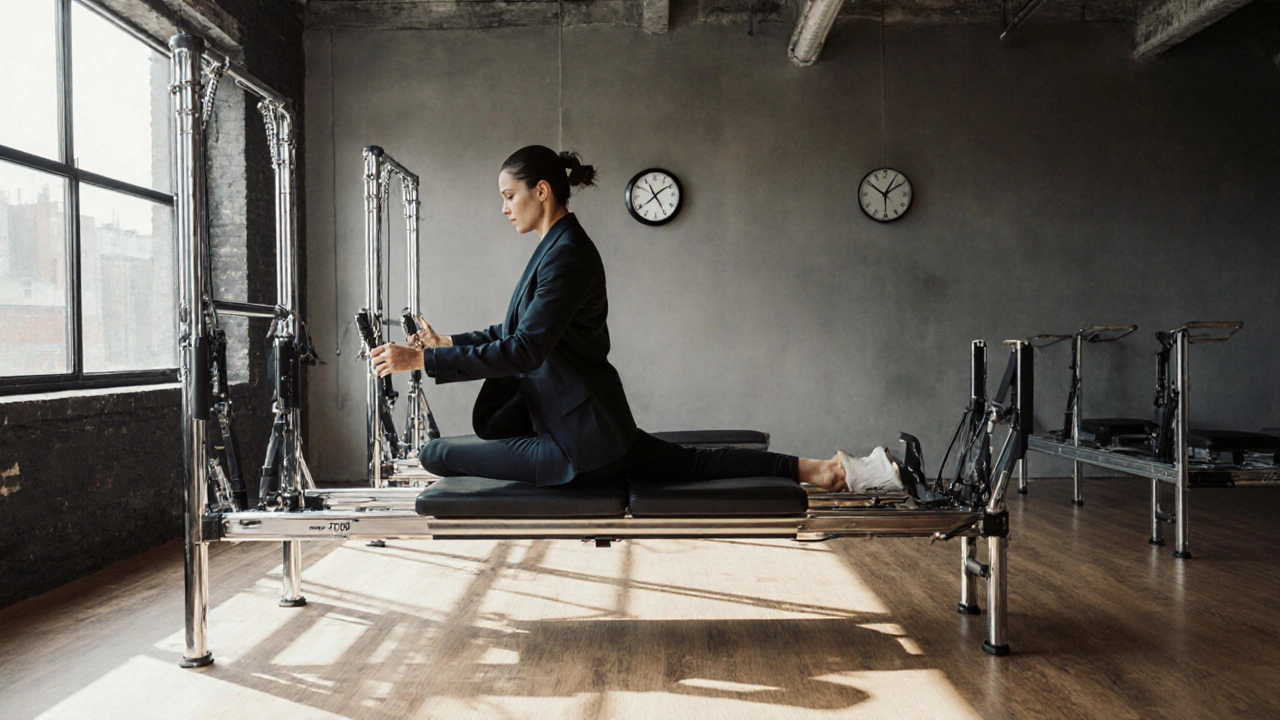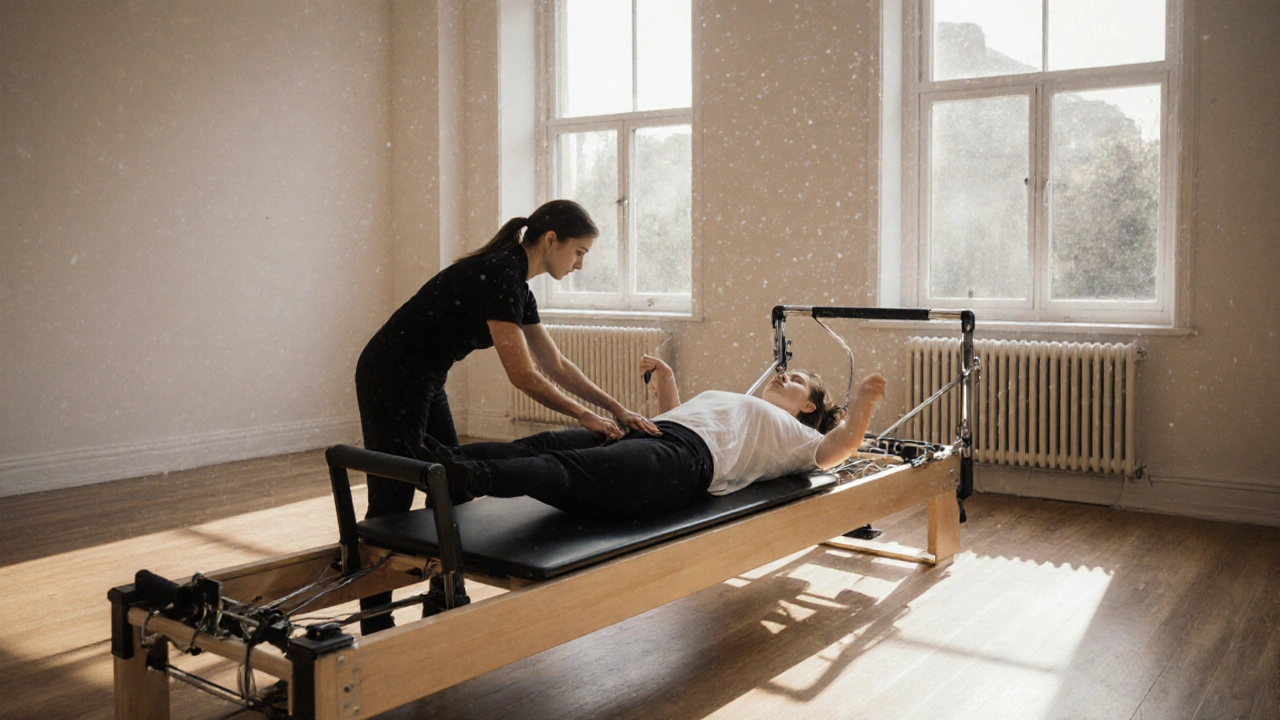Why Pilates Is the Smartest Way to Build Core Strength in London
If you’ve ever tried to lift a heavy grocery bag, get up from the floor after sitting too long, or even just stand straight without your lower back screaming-you already know how important a strong core is. Pilates isn’t just for dancers or yoga enthusiasts. It’s the most practical, low-impact way to build real, usable strength in your abs, back, and hips. And in London, you’ve got more options than ever to find a studio that fits your body, your schedule, and your goals.
Unlike crunches or sit-ups that strain your neck and give you temporary burn, Pilates teaches your body to engage muscles you didn’t even know you had. It’s not about how many reps you do. It’s about how well you do them. And the right studio can make all the difference.
What Makes a Pilates Studio in London Truly Good?
Not all Pilates studios are created equal. Some are packed with mirrors and loud music, pushing you through 60-minute routines that feel more like cardio than strength training. Others are quiet, intimate, and focused on form. Here’s what to look for:
- Small class sizes - Ideally under 8 people. You need personal feedback, not just a shouted cue from the front.
- Certified instructors - Look for teachers with at least 450+ hours of training through STOTT PILATES, Balanced Body, or Polestar. Don’t trust someone who took a weekend online course.
- Equipment variety - Reformer, Cadillac, chair, and barrel work target different muscles. A studio with just mats is fine to start, but real core transformation happens with equipment.
- Clear progress tracking - Good studios check in. They don’t just charge you monthly and disappear. They note posture changes, breathing patterns, and movement improvements.
Ask for a free trial. Most London studios offer one. Pay attention to how the instructor corrects you. If they say, “Tuck your tail,” without explaining why, walk out.
Top 5 Pilates Studios in London for Core Strength
1. The Pilates Studio (Notting Hill)
Founded in 2012 by former Royal Ballet dancer Lucy Hargreaves, this studio is all about precision. Their signature “Core Reset” class uses the Reformer and Cadillac to isolate deep abdominal muscles. Most clients report improved posture and reduced lower back pain within 6 weeks. Classes are capped at 6 people. Instructors have 800+ hours of training. The space is quiet, with natural light and no mirrors on the walls-so you focus inward, not on how you look.
2. Body Control Pilates (Soho)
Part of the UK’s largest Pilates network, Body Control is known for its clinical approach. Many of their instructors are former physiotherapists. They specialize in rehab and functional strength. If you’ve had a back injury, sit for 8 hours a day, or feel “weak in the middle,” this is your spot. Their “Core & Spine” program includes movement assessments and personalized home exercises. You’ll leave with a 30-day plan, not just a receipt.
3. Studio Pilates (Chelsea)
What sets Studio Pilates apart? They use the original Joseph Pilates method-no modern gimmicks. No music. No flashy machines. Just mat, reformer, and the pure focus of controlled movement. Their “Core Foundations” course is 8 weeks long and designed for beginners who want real strength, not just sweat. One client, a 52-year-old architect, said: “I haven’t felt this stable since I was 25. I can carry my suitcase up three flights without stopping.”
4. Core Collective (Shoreditch)
For the busy professional who doesn’t want to waste time, Core Collective offers 30-minute express sessions using the reformer. They’ve optimized every movement to maximize core activation in half the time. Their “Power Core” class combines Pilates with isometric holds and breath sequencing. You’ll burn fewer calories than in spin class-but you’ll build more functional strength. The studio is open from 6am to 9pm, with 15-minute gaps between sessions so you can fit it between meetings.
5. The Pilates Room (Islington)
This studio leans into community. They offer “Core Circles”-small groups that meet weekly to track progress, share challenges, and celebrate wins. Their founder, Maya Chen, used Pilates to recover from a herniated disc. Now she trains people with chronic pain. Their “Core + Breath” class teaches you how to use your diaphragm to stabilize your spine. It’s not about six-pack abs. It’s about building an internal corset that holds you up all day.
How to Choose Based on Your Life
Not everyone needs the same thing. Here’s how to pick the right fit:
- You work at a desk all day? Go for Body Control or The Pilates Room. They focus on spinal alignment and counteracting slouching.
- You’re recovering from an injury? Avoid high-energy studios. Stick with Body Control or The Pilates Room-they adapt movements to your limits.
- You’re short on time? Core Collective’s 30-minute sessions are the only ones in London designed for efficiency without sacrificing results.
- You want long-term habits? The Pilates Studio or The Pilates Room offer ongoing progress tracking. You won’t just be another monthly member.
- You hate group classes? Most of these studios offer private sessions. A single 60-minute private session costs £85-£110, but you’ll learn faster and avoid injury.

What to Expect in Your First Class
Don’t walk in expecting to be pushed to your limit. Pilates is subtle. The first session is usually a 15-minute chat about your goals, injuries, and daily movement habits. Then you’ll do a few basic movements: pelvic curls, spine stretches, and breathing drills. The instructor will watch how you move-not how you look.
You might feel sore the next day. Not in your abs. But in your lower back, hips, or even your inner thighs. That’s normal. That’s your deep stabilizers waking up. If you feel sharp pain, stop. Tell your instructor. Good studios adjust, not push.
How Long Until You Feel the Difference?
Most people feel more stable after 4-6 classes. That means you stand taller. You don’t hunch over your phone. You get up from chairs without using your hands. After 8 weeks, your clothes fit differently-not because you lost weight, but because your posture changed. Your core isn’t just stronger. It’s smarter.
One client, a 40-year-old teacher, kept a journal. After 10 weeks, she wrote: “I can now lift my toddler without bracing my back. I didn’t know that was possible.”
Common Mistakes to Avoid
- Doing Pilates only once a week - You need consistency. Twice a week is ideal. Once is better than nothing, but progress stalls.
- Skipping the warm-up - Pilates isn’t about jumping in. It’s about preparing your nervous system. Don’t rush it.
- Comparing yourself to others - Your body moves differently. Your core is unique. Focus on your own alignment.
- Thinking it’s easy - It looks simple. It’s not. Mastering control takes time. That’s why it works.

What to Bring
- Non-slip socks (most studios require them)
- Comfortable, form-fitting clothes (baggy leggings hide your form)
- A water bottle
- Open mind-no ego
Final Thought: Strength Isn’t About Abs. It’s About Control.
Pilates doesn’t give you a six-pack. It gives you a body that works. A body that doesn’t break down under stress. A body that moves with ease, whether you’re carrying groceries, chasing a bus, or just getting out of bed.
In London, where life moves fast and your body pays the price, Pilates isn’t a luxury. It’s a necessity. Find the studio that listens. Find the instructor who sees you. And show up-not to look good, but to feel strong.
Is Pilates better than yoga for core strength?
Yes, if your goal is functional core strength. Yoga focuses on flexibility and mindfulness. Pilates focuses on controlled movement and deep muscle engagement. Pilates targets the transverse abdominis-the body’s natural corset-more directly than most yoga poses. Studies show Pilates improves spinal stability better than yoga for people with chronic lower back pain.
Can I build core strength with just mat Pilates?
You can start with mat Pilates, and many people do. But to build real, lasting core strength, equipment like the reformer adds resistance and support that mats can’t match. The reformer lets you work against spring tension, which forces your deep muscles to activate in ways your body weight alone can’t. For serious results, combine mat and equipment work.
How much does Pilates cost in London?
Group classes range from £20 to £35 per session. Private sessions cost £85-£110. Some studios offer monthly memberships starting at £120 for 4 classes. Look for intro deals-many offer a first class for £10 or free. Don’t sign up for a 12-month contract. Try 4-6 classes first.
Do I need to be fit to start Pilates?
No. Pilates is one of the few fitness methods designed for all levels. Whether you’re 20 or 70, injured or sedentary, there’s a version for you. Good instructors modify every movement. The only requirement is willingness to move mindfully.
How often should I do Pilates to see results?
Twice a week is ideal for noticeable strength gains. Once a week helps maintain mobility. Three times a week is for faster progress. Most people feel a difference in posture and stability after 4-6 sessions. Real transformation-where your body moves differently in daily life-takes 8-12 weeks.
Next Steps: Try One Class
Don’t overthink it. Pick one studio from the list above. Book a trial. Show up 10 minutes early. Tell the instructor your goal: “I want to build core strength so I don’t hurt when I lift things.” Then move. Not hard. Not fast. Just right.
Strength isn’t built in the gym. It’s built in the quiet moments when you learn to control your own body. London has the studios. You just have to show up.
